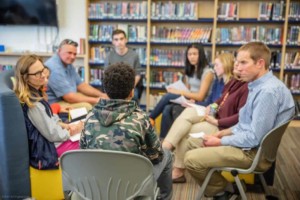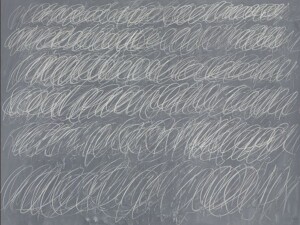Rise Above Classroom Walls On the Wings of a Bird

Ronald Reagan once said, “There are no constraints on the human mind, no walls around the human spirit, no barriers to our progress except those we ourselves erect.” This quotation has huge educational implications. I remembered these inspirational words the other night when participating with my students in our first-ever tweetup, a Twitter chatroom using a specific hashtag to discuss rhetorical strategies witnessed during the second presidential debate. Although a small minority of my students chose to attend the virtual classroom, I was overwhelmingly struck by the enormous potential.
My enthusiasm was immediately evident by the barrage of tweets I sent out during the tweetup. One of those tweets kicked off a side-discussion with Chris Kervina (@ckervina), a high school and college English teacher in Northern Virginia. The topic involved creating a shared tweetup for the final presidential debate. The idea of extending my students’ classrooms beyond the boring cement walls made me absolutely ecstatic. Suddenly the thought of my students collaborating with other brilliant minds from different regions of the United States, from a diversity of sub-cultures, from a wide range of educational backgrounds lifted me off the ground. I felt ready to take flight, ready to transcend and rise above classroom walls on the wings of a bird.
Teachers Soar High with Twitter
I truly believe there is no educational “ceiling.” Twitter proves this theory by providing educators with a means of transportation to lift forward thinkers to new altitudes. Whereas a quick walk down the hallway to a colleague’s classroom in years past usually elicited an armful of handouts, transparencies, and lesson plans, the same sharing, only in a digital version, often occurs in the fraction of a second, or roughly the time it takes to send a tweet.
Such a powerful tweet occurred the very same night Chris Kervina and I were collaborating when she invited two other educators of English, Michelle Lampinen (@michlampinen) and Sarah Mulhern Gross (@thereadingzone), to participate in a future tweetup involving our students. In just a matter of seconds, our virtual classroom without walls doubled in size. But that wasn’t the most awesome part. We needed a bit of structure, something to tie our shared vision together, and we needed an organized manner of presenting this vision to the ones who matter the most…our students. Michelle Lampinen provided this structure when she shared her lesson plan via a Google Document.
From learning objectives to literary terms to dates and specifics, Michelle Lampinen had it all covered. And shared. Perhaps the best part of the lesson plan was the list of students’ options. Whether taking part in a Twitter chat, discussing the topic on Todaysmeet.com, or reflecting on the rhetorical strategies from the debate on a teacher’s blog, each student is able to take flight by engaging in a real-world, 21st Century activity that surpasses the confines of the “one-hand-at-a-time” classroom conversation.
![]()
Students’ Full Expressions Reach New Heights
No longer do students get overly excited to write an essay or deliver a presentation for one teacher and a class of peers. Sure, they still enjoy expressing themselves and sharing their thoughts and opinions with others, but compared with the many modes of connecting to a larger, worldly audience through social media, blogs, and other creative technology tools, a paper copy just doesn’t cover the same ground.
Covering such an expansive area requires flexibility, an educational necessity validated by Mahatma Gandhi who once said, “I want freedom for the full expression of my personality.” With inflexible, rigid walls that restrict students’ intellectual reach and deprive them of new, diverse audiences, students often are not challenged enough. Interesting and original concepts may go untested in a traditional classroom where many students may have already reached a consensus based on boredom from predictable peer responses. Much needed and different points of view from distant students across the country may never be heard. In essence, students may be unable to fully express themselves due to a simple lack of exposure.
So, if classroom confinement is the enemy of students’ freedom of expression, then surely technology tools such as Twitter are the symbols of educational liberty. Like the great American Eagle flying high above a majestic mountain range, students who post their original comments via social media and blogs have a bird’s eye view of their learning. They see the peaks and valleys and mirror images of their own original thoughts, and the path ahead from such an elevation always provides a clear view.
The Results of the Tweetup? Well, They Have Yet to Land
Just under an hour after participating in our first multi-state, multi-school tweetup, I am struggling to wrap my mind around the enormity of what I just experienced. What began as a “Let’s give this a try” educational idea turned into a ninety-minute tweetup with 155 different participants and over 1,500 tweets. Simply amazing.
To grasp the concept of the virtual chatroom created through a Twitter hashtag, imagine a classroom of over a hundred participants who freely voice their detailed and focused insights without being encumbered by raising their hands and waiting for permission to speak. It was a refreshing showering of brilliant ideas and rhetorical insight.
Students from schools in New Jersey, Virginia, and Georgia engaged in a real-time analysis of rhetorical strategies such as pathos, ethos, and logos used by President Obama and Governor Romney during the final presidential debate. Using the hashtag #bamrom12, students connected with peers from different areas and with various viewpoints. Students retweeted other students and replied to interesting comments. At first, the interaction was a bit slow as most were merely concerned with posting their own opinions. However, they soon caught on and began to interact with each other.
As I did my best to participate in the Twitter tweetup and the todaysmeet.com chatroom, I found myself mesmerized by the sheer freedom of the students. I returned to Reagan’s quotation again and marveled at the lack of intellectual constraint, classroom walls, and obstacles that ultimately deter students from fully expressing themselves. Then it dawned on me. They were free as a bird.
I can see it so clearly now. No obstructions blocking my view anymore.
After all, there are no walls this high up.
(Click here for a sample of the #bamrom12 tweetup.)








0 Comments
Leave a Comment
Your email address will not be published. All fields are required.